Fuzzy-Approximation-Based Novel Back-Stepping Control of Flexible Air-Breathing Hypersonic Vehicles with Nonaffine Models
Abstract
This article investigates a novel fuzzy-approximation-based nonaffine control strategy for a flexible air-breathing hypersonic vehicle (FHV). Firstly, the nonaffine models are decomposed into an altitude subsystem and a velocity subsystem, and the nonaffine dynamics of the subsystems are processed by using low-pass filters. For the unknown functions and uncertainties in each subsystem, fuzzy approximators are used to approximate the total uncertainties, and norm estimation approach is introduced to reduce the computational complexity of the algorithm. Aiming at the saturation problem of actuator, a saturation auxiliary system is designed to transform the original control problem with input constraints into a new control problem without input constraints. Finally, the superiority of the proposed method is verified by simulation.
1. Introduction
Air-breathing hypersonic vehicle (AHV) is a kind of high-velocity aircraft flying at more than 5 times the speed of sound and cruising at an altitude in the near space. With the increasing extension of human activities to space, high-velocity and high-altitude vehicles represented by air-breathing hypersonic vehicles will play an important role in the field of aerospace. The control system is the “nerve center” of an aircraft, and the design of the AHV control system has become one of the frontier issues in the field of control science [1].
Compared with traditional aircrafts, the flight environment of flexible air-breathing hypersonic vehicles is more complex, the flight envelope span is larger, and the aerodynamic characteristic change is more complex. These problems bring difficulties to the design of the FHV control system. At the same time, in the control theory, FHV has the characteristics of strong nonlinearity, strong coupling, fast time-varying, and uncertainty, which make FHV extremely sensitive to flight attitude in dynamic characteristics, and the design of the FHV control system is also subject to many constraints [2–4].
For the control of FHV, previous research has achieved fruitful results, for example, sliding mode variable structure control [5–8], neural network control [9–11], prescribed performance control [12–14], and fuzzy control [15, 16]. Hu et al. designed the FHV robust controller and the observers by means of sliding mode control in [6]. But in practical application, chattering problem exists in sliding mode control. In [7], the method of multimode switching between ordinary sliding surface and integral sliding surface is proposed to solve the chattering problem, but the switching between sliding surfaces is still relatively complex. In [8], Song et al. studied the double-loop sliding mode control method of HFV, unknown disturbances are observed by sliding mode observers, which enhanced the robustness of the control law. Bu et al. proposed an adaptive neural control method in [10]. The simulation results show that the control method can still guarantee the stable tracking of flight velocity and altitude to their respective reference inputs. In [11], the altitude subsystem of HFV is rewritten to a pure feedback form, and an adaptive neural control law is designed to ensure the realizability of the control law. By constructing the prescribed performance functions in [14], the velocity tracking error and altitude tracking error of FHV are guaranteed, and the prescribed transient performance and steady-state accuracy of the system are satisfied. In [16], unknown functions of FHV models are approximated online by using fuzzy systems, but the algorithm requires that the unknown functions be strictly positive and bounded. There are a lot of unknown functions in each subsystem, and computational costs are heavy.
Most of the above studies focus on the affine models of FHV, which require simplifying the nonaffine models of FHV to the complete affine forms of the control input under certain assumptions, and then conducting research [17]. However, in fact, many of the dynamic performances of FHV are nonlinear functions of rudder deflection, angle of attack, velocity, and altitude. Particularly in the hypersonic flight process of FHV, these nonaffine dynamic characteristics cannot be affine, so it is necessary to strengthen the study of nonaffine models of FHV. [18] designed a control law of FHV based on the Mean Value Theorem [19], which has achieved certain effects. In [20], for a class of high-order nonaffine nonlinear systems with completely unknown dynamics, Meng et al. developed a novel system transformation to transform the nonaffine system into an affine system. According to the idea expressed in [20, 21] combined the system transformation with prescribed performance control scheme, the simulation results verified the effectiveness of the method. In [22], the novel system transformation with a low-pass filter is applied to constrained systems.
- (1)
The traditional affine models need to simplify the nonaffine dynamics into fully affine forms. In this article, low-pass filters are used to solve the nonaffine dynamics of FHV
- (2)
For each subsystem of FHV, only a fuzzy approximator is introduced to approximate the total uncertainties in the subsystem, which reduces the computational complexity of the system on the basis of ensuring the robustness of the controller. At the same time, the norm estimation approach is introduced in this article to ensure the computational speed compared with the previous fuzzy control method
- (3)
Compared with the traditional back-stepping control method, all the virtual controllers proposed in this article are only used as intermediate variables for the stability analysis of the system and do not participate in the final solution and execution
- (4)
An auxiliary system is introduced to transform the original control problem with input constraints into a new control problem without input constraints to solve the transient saturation problem in the control input
2. FHV Model and Preliminaries
2.1. FHV Model
The control inputs are fuel-air ratio Φ and elevator deflection angle δe; the average aerodynamic chord length of FHV is ; the reference area is S; represents the dynamic pressure of FHV; the air density at h is ρ; zT is the coupling coefficient of thrust and moment; ce represents rudder deflection coefficient; h0 represents nominal altitude; the air density at nominal altitude is ρ0; 1/hs is the decay rate of air density.
Remark 1. In the following controller design, the rigid body states can be measured, and the elastic modes are usually regarded as the unknown dynamics, which are treated as the robustness of the controller [10, 25].
Remark 2. It can be seen from equation (10) that the FHV models are nonaffine for the control inputs, because the parameter fitting form of resistance D contains [17]. Therefore, in the subsequent control system design, based on the back-stepping control framework, in the case of uncertainties and nonaffine dynamics, fuzzy-approximation-based nonlinear tracking control laws Φ and δe are designed to achieve robust tracking of velocity and altitude commands Vref and href.
Remark 3. Because the fuel-air ratio Φ is related to thrust T, so the velocity V is mainly controlled by Φ. The elevator angle δe controls the change of altitude h by affecting the pitch rate Q, pitch angle θ, and track angle γ. Therefore, the FHV models can be decomposed into velocity subsystem (equation (1)) and altitude subsystem (equations (2)-(5)), and then the control laws are designed separately [26].
2.2. Theory of Fuzzy Approximation
In equation (12), is the jth (j = 1, ⋯, N) fuzzy rule corresponding to the ith (i = 1, ⋯, n) input point, N is the number of fuzzy rules, is the membership function, . In this article, the Gauss basis function is chosen as the membership function.
Lemma 1 [27]. Suppose that the real continuous function F(X) is an arbitrary function defined on compact set Ω. For any μ > 0, the fuzzy system can be obtained, and the following conditions are guaranteed:
2.3. Saturation Auxiliary System
According to equation (16) and the characteristic of the sigmoid function, whether Φ and δe take any value, the saturation auxiliary system can make Φc and δec meet the constraints of equation (15).
Remark 4. In the controller design, the original control objective can be converted to design unconstrained Φ and δe such that velocity Vand altitude h track their reference commands Vref and href.
2.4. Controller Design
In the following section, the altitude subsystem and velocity subsystem of the controller are designed with the new fuzzy-approximation-based control scheme in this article.
2.4.1. Controller Design of the Altitude Subsystem
In the altitude subsystem, we design an altitude controller based on nonaffine dynamics and a fuzzy approximator to achieve stable tracking of reference altitude href.
If the design parameters kh,1 > 0, kh,1 > 0 and γ → γd, then can be regulated to zero exponentially [29]. In this way, the control objective of the altitude subsystem can be transformed to γ → γd by designing the appropriate control law δe.
Next, transform the nonaffine models.
The fuzzy-approximation-based altitude subsystem controller is designed by using the transformed affine form.
Remark 5. According to the theory of input-to-state stability, when the input is bounded, the state of the system is also bounded. So we need to prove the boundedness of uh.
Theorem 1. If the control inputs uh are bounded, there must be fixed values uhM, such that
Proof. Define the Lyapunov function
Taking time derivative along (28).
If τh > 1/2, ψh,4 will ultimately converge to the compact , where . That is, ψh,4 is bounded and the low-pass filter “” is stable when uh is bounded.
Define tracking error eh,1 as
Taking time derivative along (30) and employing (26), it leads to
Define intermediate variable υ2d as
Then, define tracking error eh,2 as
Applying (26), the time derivative of eh,2 is derived as
Define a new intermediate state variable υ3d as
Define tracking error eh,3 as
Differentiating along (36) with respect to time and applying (26), we get
Then, the intermediate variable υ4d is designed as
Finally, define tracking error eh,4 as
Taking the time derivative of eh,4 and invoking (26) lead to
Define unknown function Fh as
Finally, the control law is devised as
Substitute equation (32) into equation (33) to obtain
Taking time derivative along (46),
By combining equations (26) and (35), equation (36) can be obtained.
Substituting equations (46) and (47) into equation (48), it yields
Taking time derivative along (49), we obtain
Substituting (26) and (38) into (39), eh,4 is formulated as
Combining equations (46), (49), and (50), we can obtain
Substituting (49) and (52) into (44) leads to
Remark 6. Unlike the back-stepping control method proposed by Bu et al. [30], the presented altitude controller is exploited using an improved back-stepping framework, in which the virtual controller is transformed into intermediate variables and only the final actual control laws are needed to be implemented, which avoids repeated calculation and greatly reduces the computational pressure of the system.
Remark 7. Compared with the method in [16, 31, 32], each weight update requires a lot of calculation. In this article, only one online learning parameter is needed by using the norm estimation approach, which makes the online calculation of the system significantly reduced.
Theorem 2. Considering the closed-loop subsystem consisting of plant (26), with controller (53), and adaptive law (45). Then all the signals involved are semiglobally uniformly ultimately bounded.
Proof. Consider the following Lyapunov function:
Applying (31), (34), (37), (40), (41), and (45), is derived as
Considering (32), (35), and (38), becomes
Substituting (44) into (56) yields, we can get
From the fact that
we obtain
Thereby, equation (57) becomes
In this article, since , and applying (12), we know that 0 ≤ ξj(X) ≤ 1. There exists a constant, such that . Hence, we get
Then, (60) becomes
Let , , λh,2 > 0, λh,3 > 0, and l1 > 0. And define the following compact sets
If or or or or , will be negative. It is clear that eh,1, eh,4, eh,2, eh,3 and are semiglobally uniformly ultimately bounded. This completes the proof.
2.5. Controller Design of Velocity Subsystem
For the velocity subsystem, its tracking target is to achieve the stable tracking of velocity V to reference velocity Vref.
Remark 8. Noting that α ∈ [−8.7rad, 8.7rad, ] × 10−2α ∈ [−8.7 rad, 8.7 rad] × 10−2, so we can get the definitions of α2 and α3 as α2 ∈ [0 rad2, 7.57 rad2] × 10−3 and α3 ∈ [−6.5850 rad3, 6.5850 rad3] × 10−4, respectively. And we can calculate that КV > 0.
Next, we need to prove the boundedness of uV.
Theorem 3. If the control input uV is bounded, there must be a fixed value uVM, such that
Proof. Construct the Lyapunov function
Taking time derivative along (69)
If τV > (1/2), ψV,2 will ultimately converge to the compact . Where . As a result, the boundedness of uh leads to the newly introduced system “” which is stable.
Define tracking error eV,1 as
Taking time derivative along (71) and employing (67), it leads to
Define intermediate variable ε2d as
Define tracking error eV,2 as
Utilizing (67) and (73), the time derivative of eV,2 is derived as
is the input vector of the unknown function; is the parameter vector of ideal weight coefficient, fuzzy basis function . The unknown function FV can be expressed as
The velocity control law is designed as
Substituting equations (67) and (73) into equation (74), we can obtain
Substitute equation (80) into equation (78) to get
Theorem 4. Considering the closed-loop subsystem consisting of plant (67), with controller (81) and adaptive law (79). Then, all the signals involved are semiglobally uniformly ultimately bounded.
Proof. Consider the following Lyapunov function candidate:
Applying (73), (74) into (72), is expressed as
Considering (75), (77), and (79), becomes
To simplify equation (84) and substituting (78) into (84) yields, we can get
From the fact that
we obtain
Thereby, equation (85) becomes
In this article, since, and applying (12), we know that 0 ≤ ξj(X) ≤ 1.There exists a constant, such that . Hence, we get
Then, (88) becomes
Let , , l2 > 0. And define the following compact sets:
If or or , will be negative. Thus, eV,1, eV,2, and are semiglobally uniformly ultimately bounded. This is the end of the proof.
3. Simulation Results
To verify the effectiveness of the new control strategy proposed in this article, the proposed controller is tested in the simulation adopting the nonlinear models (1)-(7) implemented in MATLAB/SIMULINKs. The simulation step size is fixed, the step size is 0.01 s, and the simulation period is 100 s. The initial trim conditions of the FHV are shown in Table 1. The velocity step ΔV = 100 m/s, altitude step Δh = 200. Both the velocity and altitude reference inputs are given by a second-order reference model with a damping ratio of 0.95 and a natural frequency of 0.03rad/s. All the aerodynamic coefficients and parameters are the same as [17, 23].
| Item | Value | Units |
|---|---|---|
| V | 2500 | m/s |
| h | 27000 | m |
| γ | 0 | deg |
| θ | 1.5295 | deg |
| Q | 0 | deg/s |
| η1 | 0.2857 | — |
| η2 | 0.2857 | — |
The fuzzy function approximators choose the Gauss basis functions as the membership functions, set the fuzzy set of each variable to 100. The input vectors are , . Where the fuzzy centers iV, iγ, iθ, iQ, iΦ and iδe of each fuzzy set are uniformly distributed on [2500 m, 2800 m], [−1.1°, +1.1°], [0°, 11.5°], [−5.7°/s, +5.7°/s], [0, 2], and [−23°, +23°], respectively. The membership functions of the above variables are shown in Table 2. To show the superiority of the proposed method, we do the simulation study compared with recent research methods of others. The following two different cases are considered.
Case 1. The method proposed in this paper (controller 1) is compared with the novel back-stepping control method (controller 2) in [33] without adding the saturation auxiliary system.
| V | γ | θ | Q | Φ | δe |
|---|---|---|---|---|---|
|
|
|
|
|
|
|
The obtained simulation results are shown in Figures 1–7. As can be seen from Figures 1 and 2, both of the two methods can achieve the desired tracking effects, but the tracking accuracy of controller 1 is higher than that of controller 2 in both altitude tracking effects and velocity tracking effects. According to Figure 3, the attitude angle changes of the two methods are roughly the same, but the change amplitude of controller 1 is less than that of controller 2. Figure 4 shows that the trend of Φ and δe are similar, the lines are relatively smooth, there is no high-frequency chattering phenomenon, and the amplitude of controller 1 is small. Figure 5 shows that uV and uh are bounded. Finally, variation curves of flexible states and the estimations of φ1 and φ2 are presented in Figures 6 and 7.
Case 2. Assuming that the actuators are subject to theoretical constraints: Φ ∈ [0.05,1.2], δe ∈ [−18°, 18°]. The closed-loop system simulation of FHV is carried out by using the method presented in this paper (controller 1) and the method of adaptive neural control with nonaffine dynamics (controller 2) in [34].
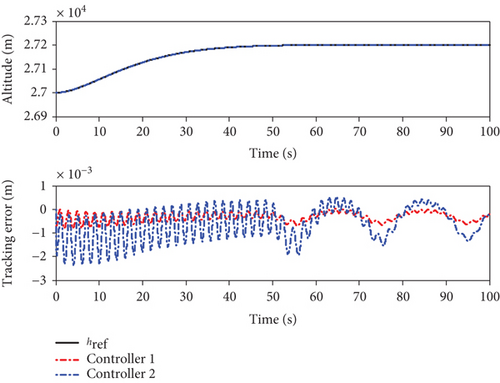
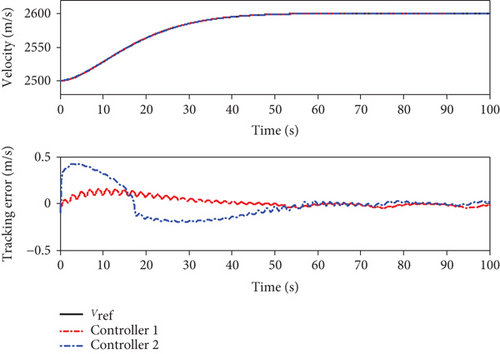
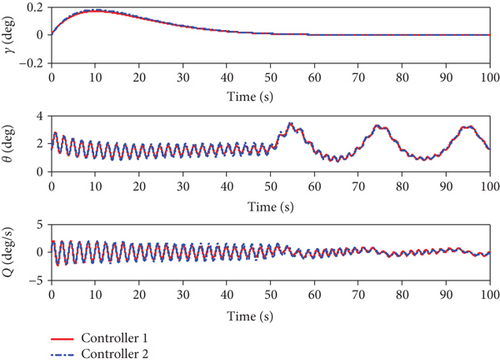
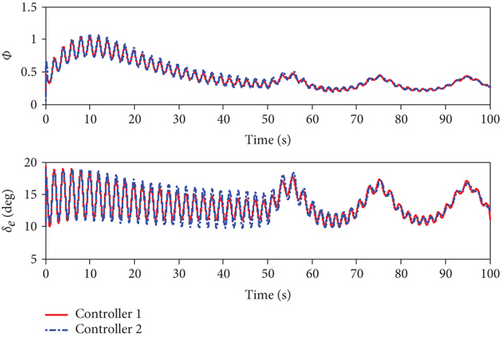
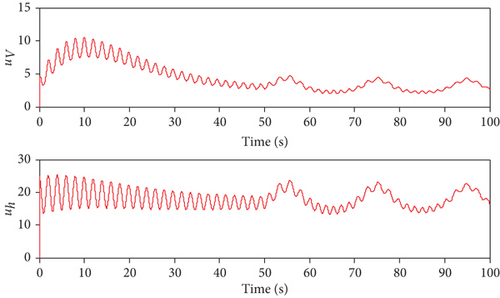
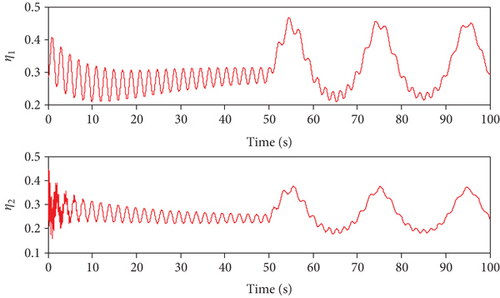
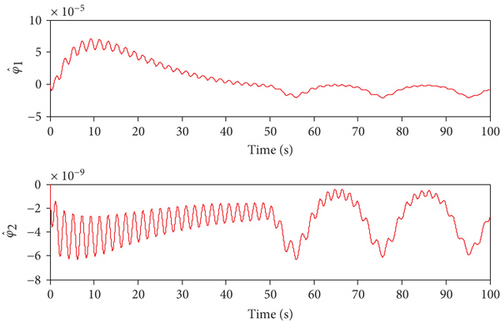
When the actuators are constrained, the simulation results using the two methods are shown in Figures 8–14. From Figures 8 and 9, it can be seen that both two methods can achieve stable tracking of reference altitude and velocity, but the altitude tracking error and velocity tracking error in controller 2 are relatively large, the maximum altitude tracking error is more than 4 m, and the maximum velocity tracking error is close to 2 m/s. At the same time, it can be seen from Figure 10 that the attitude angle changes of controller 1 are obviously smoother than that of controller 2. In Figure 11, although controller 2 can maintain the robustness of the system, the actuators are saturated for a long time. When controller 1 is saturated, it can also rely on the auxiliary system to maintain the stability of the system. In Figure 12, uV and uh are bounded. Variation curves of flexible states and the estimations of φ1 and φ2 are presented in Figures 13 and 14. To sum up, in both cases, the superiority of the proposed method can be demonstrated.
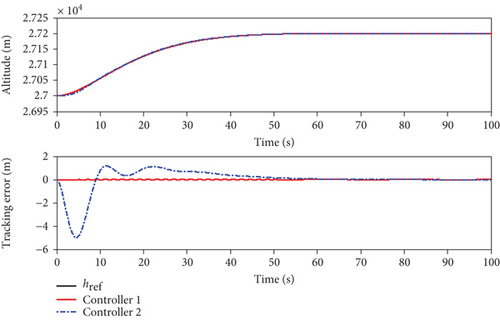
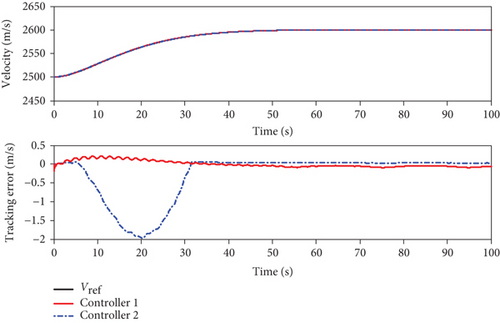
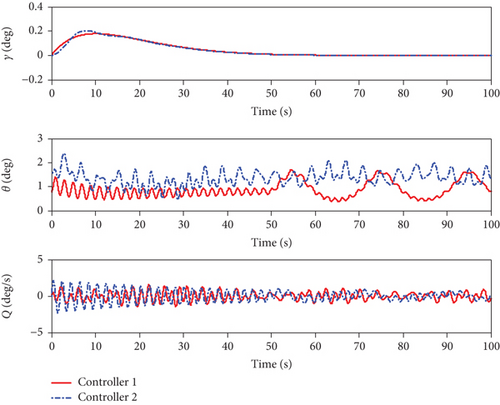
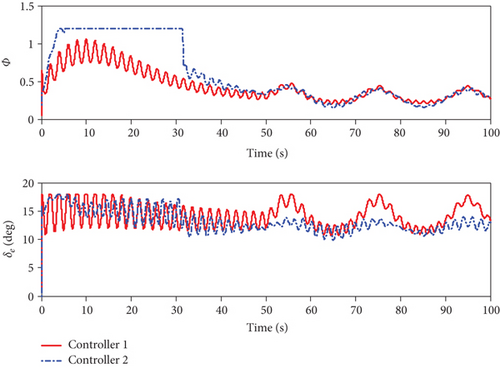
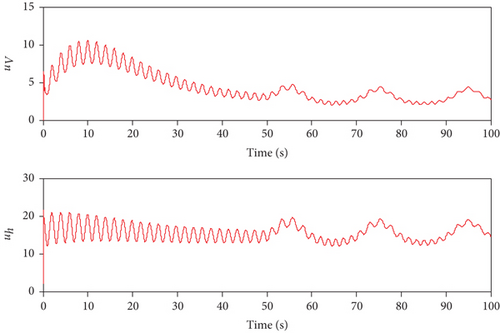
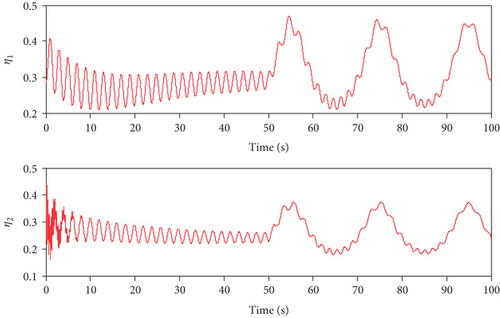
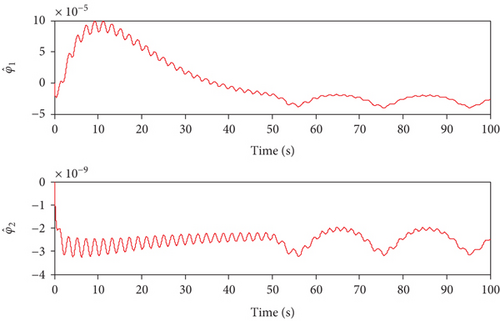
4. Conclusions
- (1)
In this paper, a fuzzy-approximation-based novel back-stepping control method is proposed. The method does not need virtual control laws, but only needs a final actual control law, and the control algorithm is more simplified
- (2)
For each subsystem of FHV, only a fuzzy approximator is needed to approximate the total uncertainties in the subsystem. Meanwhile, the norm estimation approach is introduced to directly estimate the norm of the weight vector in the fuzzy approximator, instead of the element itself, which reduces the computational complexity of the control algorithm and guarantees the real-time performance of the algorithm
- (3)
The control method in this paper is based on nonaffine models and uses low-pass filters to deal with nonaffine dynamics, avoiding the loss of dynamic characteristics in affine models
- (4)
The saturation problem of actuators in nonaffine models is discussed. By designing an auxiliary system, the original control problem with input constraints is transformed into a new control problem without input constraints
- (5)
In two cases, the simulation results are compared with the recent methods to verify the advantages of the proposed method
Conflicts of Interest
The authors declare that there is no conflict of interest regarding the publication of this paper.
Acknowledgments
This work was supported by the Aeronautical Science Foundation of China (Grant No. 20175896023) and the National Natural Science Foundation of China (Grant Nos. 61603410, 61703424).
Open Research
Data Availability
The data used to support the findings of this study are included within the article.




